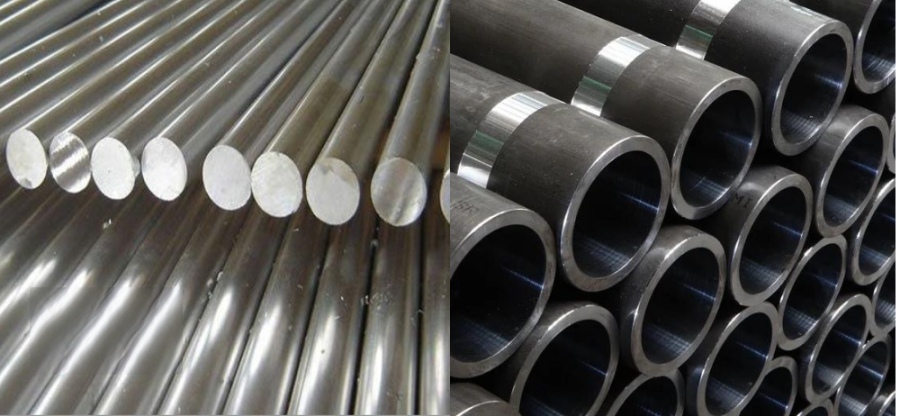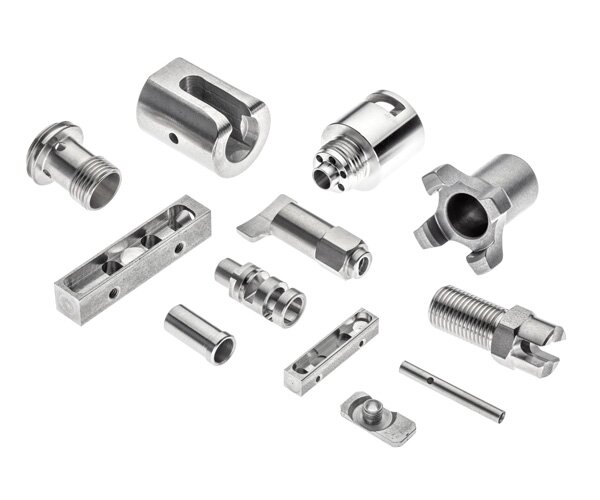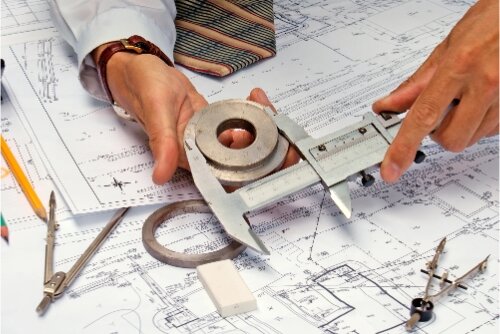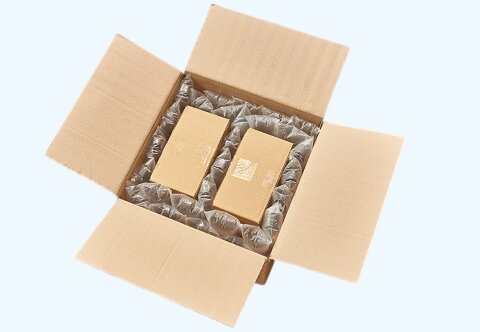هل شعرت بالحيرة عند الاختيار بين الفولاذ المقاوم للصدأ 303 و304؟ لست وحدك. فالعديد من المهندسين والمصنعين يعانون من هذا القرار. فكلا النوعين يوفران مقاومة للتآكل والمتانة، ولكن يمكن أن تؤثر الاختلافات الطفيفة بينهما بشكل كبير على نجاح مشروعك. دعنا نوضح لك الحيرة ونساعدك على الاختيار الصحيح.
والفرق الرئيسي بين الفولاذ المقاوم للصدأ 303 و304 هو تركيبها وخصائصها. يحتوي 303 على كبريت مضاف لتحسين قابلية التشغيل الآلي، بينما يوفر 304 مقاومة أفضل للتآكل وقابلية اللحام. ويعتمد اختيارك على احتياجات الاستخدام الخاصة بك، مثل متطلبات التشغيل الآلي أو التعرض لبيئات التآكل.
هل لديك فضول لمعرفة كيف تؤثر هذه الاختلافات على مشروعك؟ سنستكشف الخصائص الفريدة لكل نوع، وأفضل التطبيقات، وكيفية الاختيار بينها. في النهاية، ستفهم بوضوح أي نوع من الفولاذ المقاوم للصدأ يناسب احتياجاتك.

أساسيات الفولاذ المقاوم للصدأ
الفولاذ المقاوم للصدأ هو سبيكة من الحديد والكروم وعناصر أخرى. وهو معروف بمقاومته للتآكل والصدأ. وتؤدي إضافة الكروم إلى تكوين طبقة واقية على السطح، مما يمنح الفولاذ المقاوم للصدأ خصائصه المميزة.
ما هو الفولاذ المقاوم للصدأ 303؟
الفولاذ المقاوم للصدأ 303 هو فولاذ أوستنيتي. يحتوي على الكبريت، مما يحسن من قابليته للتشغيل الآلي. وهذا يجعله مثاليًا للتطبيقات التي تتطلب تشغيلًا آليًا أو حفرًا مكثفًا. وغالباً ما يستخدم 303 في الأجزاء التي تحتاج إلى تشكيل دقيق، مثل البراغي والصواميل والبراغي.
ما هو الفولاذ المقاوم للصدأ 304؟
كما أن الفولاذ المقاوم للصدأ 304 من الفولاذ الأوستنيتي. وهو معروف بمقاومته الممتازة للتآكل وقابليته الممتازة للتشكيل. لا يحتوي 304 على الكبريت المضاف الموجود في 303. يُستخدم هذا النوع من الفولاذ على نطاق واسع في مختلف الصناعات، من معدات المطابخ إلى التطبيقات الصناعية.
فهم درجات الفولاذ المقاوم للصدأ
تشير درجات الفولاذ المقاوم للصدأ إلى تركيبة الفولاذ وخصائصه. تساعد هذه الدرجات المهندسين والمصنعين على اختيار النوع المناسب لاحتياجاتهم.
كيف يتم تصنيف التقديرات
تُصنف درجات الفولاذ المقاوم للصدأ بناءً على تركيبها البلوري وعناصر السبائك. والفئات الرئيسية هي الأوستنيتي والحديدي والمارتنسيتي والمزدوج. يندرج كل من 303 و304 تحت فئة الأوستنيتي.
لماذا يُصنَّف الفولاذ المقاوم للصدأ على أنه 303 و304
طور المعهد الأمريكي للحديد والصلب (AISI) نظام ترقيم الفولاذ المقاوم للصدأ. تشير السلسلة 300 إلى الفولاذ الأوستنيتي المقاوم للصدأ، وتشير الأرقام المحددة 303 و304 إلى التركيب والخصائص الفريدة لكل نوع.
الفولاذ المقاوم للصدأ 303: الخصائص والخصائص
يتميز الفولاذ المقاوم للصدأ 303 بقابليته الممتازة للتشغيل الآلي، مما يجعله خيارًا شائعًا للتطبيقات التي تتطلب أشكالًا معقدة أو تشغيل آلي دقيق. دعونا نتفحص خصائصه وخصائصه المحددة.
التركيب الكيميائي للفولاذ المقاوم للصدأ 303
تنبع الخصائص الفريدة للفولاذ المقاوم للصدأ 303 من تركيبته الكيميائية. ويمنح هذا المزيج المحدد من العناصر 303 خصائصه المميزة.
يحتوي الفولاذ المقاوم للصدأ 303 على الكروم (17-19%) والنيكل (8-10%) والكبريت (0.15% كحد أدنى). وتميز إضافة الكبريت 303 عن أنواع الفولاذ المقاوم للصدأ الأخرى. كما يحتوي أيضًا على كميات صغيرة من السيليكون والمنجنيز والفوسفور.
الخواص الميكانيكية للفولاذ المقاوم للصدأ 303
الخصائص الميكانيكية للفولاذ المقاوم للصدأ 303 تجعله مناسبًا لمختلف التطبيقات. تحدد هذه الخواص كيفية تصرف المادة تحت أنواع مختلفة من الإجهاد.
يتميز الفولاذ المقاوم للصدأ 303 بقوة شد تبلغ حوالي 515 ميجا باسكال وقوة خضوع تبلغ 205 ميجا باسكال. وتتراوح صلابة برينل من 160 إلى 190. هذه الخصائص تجعله قويًا بما فيه الكفاية للعديد من الاستخدامات مع سهولة تشغيله آليًا نسبيًا.
قابلية التصنيع الآلي للفولاذ المقاوم للصدأ 303
تتمثل إحدى المزايا المهمة للفولاذ المقاوم للصدأ 303 في قابليته الفائقة للتشغيل الآلي. وهذه الخاصية تجعله المفضل لدى المصنعين الذين يحتاجون إلى صنع أجزاء معقدة أو دقيقة.
يشكل الكبريت المضاف في 303 شوائب كبريتيد المنجنيز. تعمل هذه الشوائب كقواطع للبُرادة أثناء التصنيع، مما يؤدي إلى برادة أقصر وحركة قطع أكثر سلاسة. وهذا يؤدي إلى تشطيبات سطحية أفضل وعمر أطول للأداة.
مقاومة الفولاذ المقاوم للصدأ 303 للتآكل
على الرغم من أن 303 يوفر مقاومة جيدة للتآكل، إلا أنه أقل مقاومة من الفولاذ المقاوم للصدأ الآخر. ويختلف أداؤه باختلاف البيئة.
يعمل 303 بشكل جيد في البيئات الخفيفة المسببة للتآكل. ومع ذلك، فهو أقل مقاومة لظروف التآكل الشديدة مقارنةً ب 304. فهو معرض بشكل خاص للتآكل الناتج عن التآكل في البيئات الغنية بالكلوريد.
التطبيقات النموذجية للفولاذ المقاوم للصدأ 303
إن الخصائص الفريدة للفولاذ المقاوم للصدأ 303 تجعله مناسبًا لمختلف التطبيقات في مختلف الصناعات.
يستخدم 303 بشكل شائع في صناعات السيارات والفضاء ومعالجة الأغذية. وغالبًا ما يوجد في التروس، والأعمدة، والمسامير، والصواميل، وأجزاء الماكينات الأخرى التي تتطلب معالجة آلية واسعة النطاق. ويستخدم أيضًا في بعض معدات مناولة الأغذية، على الرغم من أن 304 أكثر شيوعًا نظرًا لمقاومته الفائقة للتآكل.

الفولاذ المقاوم للصدأ 304: الخصائص والخصائص
يشتهر الفولاذ المقاوم للصدأ 304 بمقاومته الممتازة للتآكل وتعدد استخداماته. وهو من بين أكثر درجات الفولاذ المقاوم للصدأ استخدامًا في مختلف الصناعات. دعونا نستكشف خصائصه وخصائصه المحددة.
التركيب الكيميائي للفولاذ المقاوم للصدأ 304
إن التركيب الكيميائي للفولاذ المقاوم للصدأ 304 يمنحه مزيجًا فريدًا من الخصائص، وهو ما يميزه عن درجات الفولاذ المقاوم للصدأ الأخرى، بما في ذلك 303.
304 يحتوي الفولاذ المقاوم للصدأ 304 على الكروم (18-20%) والنيكل (8-10.5%). وعلى عكس 303، فإنه لا يحتوي على كبريت مضاف. كما يحتوي على كميات صغيرة من الكربون والمنجنيز والسيليكون والفوسفور. ينتج عن هذه التركيبة مقاومة ممتازة للتآكل وقابلية تشكيل جيدة.
الخواص الميكانيكية للفولاذ المقاوم للصدأ 304
إن الخواص الميكانيكية للفولاذ المقاوم للصدأ 304 تجعله مناسبًا لمجموعة واسعة من التطبيقات. وتحدد هذه الخواص كيفية أداء المادة تحت مختلف الضغوط والظروف البيئية.
يتميز الفولاذ المقاوم للصدأ 304 بقوة شد تتراوح بين 515 و620 ميجا باسكال تقريبًا وقوة خضوع تبلغ 205 ميجا باسكال. وتتراوح صلابته من 123 إلى 220. وتوفر هذه الخصائص توازنًا جيدًا بين القوة والمرونة، مما يجعله مناسبًا ل تشكيل و لحام.
مقاومة الفولاذ المقاوم للصدأ 304 للتآكل
إحدى الميزات البارزة للفولاذ المقاوم للصدأ 304 هي مقاومته الممتازة للتآكل، مما يجعله مثاليًا للاستخدام في بيئات مختلفة.
يوفر الفولاذ المقاوم للصدأ 304 مقاومة فائقة للتآكل في العديد من البيئات. ويعمل بشكل جيد في الأجواء المؤكسدة والعديد من المواد الكيميائية العضوية وغير العضوية. ومع ذلك، يمكن أن يكون عرضة للتآكل في البيئات التي تحتوي على نسبة عالية من الكلوريد.
قابلية لحام الفولاذ المقاوم للصدأ 304
يشتهر الفولاذ المقاوم للصدأ 304 بقابليته الممتازة للحام. وهذه الخاصية تجعله خيارًا شائعًا للتطبيقات التي تتطلب الربط أو التصنيع.
يمكن لحام ثلاثمائة وأربعة باستخدام معظم تقنيات اللحام القياسية. ويحافظ على مقاومته للتآكل بعد اللحام، وهو أمر ضروري للعديد من التطبيقات. يساهم غياب الكبريت المضاف (على عكس 303) في قابليته الفائقة للحام.
التطبيقات النموذجية للفولاذ المقاوم للصدأ 304
إن الجمع بين مقاومة التآكل والقوة والقابلية للتشكيل يجعل الفولاذ المقاوم للصدأ 304 مناسبًا لمختلف التطبيقات في مختلف الصناعات.
يشيع استخدام 304 في المعدات والأواني في صناعة الأغذية والمشروبات. كما يوجد في التطبيقات المعمارية ومعدات المعالجة الكيميائية والمبادلات الحرارية. وفي صناعة السيارات، يُستخدم في أنظمة العادم والزخارف. ستجد أيضًا 304 في الأجهزة المنزلية والأحواض وأواني الطهي.
الفولاذ المقاوم للصدأ 303 مقابل 304 الفولاذ المقاوم للصدأ 303 مقابل 304 الفولاذ المقاوم للصدأ : الاختلافات الرئيسية
يُعد فهم الاختلافات الرئيسية بين الفولاذ المقاوم للصدأ 303 و304 أمرًا بالغ الأهمية لاختيار المادة المناسبة لمشروعك. دعنا نقسم هذه الاختلافات إلى عدة فئات مهمة.
الاختلافات الكيميائية بين 303 و 304
يحدد التركيب الكيميائي الأساس للخصائص المميزة للفولاذ المقاوم للصدأ 303 و304:
- محتوى الكبريت: يحتوي 303 على الكبريت المضاف (0.15% كحد أدنى)، بينما لا يحتوي 304 على
- الكروم: يحتوي كلاهما على كميات متشابهة (17-19% في 303، 18-20% في 304)
- النيكل: أعلى قليلًا في 304 (8-10.5%) مقارنة ب 303 (8-10%)
- الفوسفور: أعلى في 303 (0.20% كحد أقصى) من 304 (0.045% كحد أقصى)
تؤثر هذه الاختلافات في التركيب بشكل مباشر على خصائص وأداء كل نوع من أنواع الفولاذ.
الاختلافات الميكانيكية بين 303 و304
على الرغم من أن كلا الفولاذين يتمتعان بقوة متشابهة، إلا أن هناك بعض الاختلافات الملحوظة:
- قوة الشد: يحتوي 304 على نطاق أعلى قليلاً (515-620 ميجا باسكال) مقارنةً ب 303 (515 ميجا باسكال)
- قوة العائد: كلاهما له نفس قوة الخضوع (205 ميجا باسكال)
- صلابة: 304 لديه نطاق صلابة برينل أكثر شمولاً (123-220) من 303 (160-190)
- اللدونة: 304 يميل إلى أن يكون أكثر ليونة بسبب عدم وجود الكبريت
وتؤثر هذه الخواص الميكانيكية على كيفية أداء كل نوع من أنواع الفولاذ في التطبيقات المختلفة.
مقارنة مقاومة التآكل
مقاومة التآكل عامل حاسم في الاختيار بين 303 و304:
- مقاومة عامة للتآكل: يتفوق أداء 304 على 303
- مقاومة التأليب: تتميز 304 بمقاومة أفضل للتآكل التنقر
- تآكل الشقوق: 304 أكثر مقاومة للتآكل الشقوق 304
- الأداء في بيئات الكلوريد: أداء 304 أفضل من 303
مقاومة 304 الفائقة للتآكل تجعلها أكثر ملاءمة للتطبيقات في البيئات القاسية.
قابلية التصنيع الآلي مقابل قابلية اللحام
ربما يكون هذا هو الفرق الأكثر أهمية بين 303 و304:
- القدرة على التصنيع: 303 متفوق بسبب محتواه المضاف إليه الكبريت
- قابلية اللحام: 304 تتفوق في تطبيقات اللحام
- تشطيب السطح: 303 يسمح بتحسين التشطيبات السطحية في الأجزاء المشغولة آليًا
- خصائص ما بعد اللحام: يحافظ 304 على خواصه بشكل أفضل بعد اللحام
هذه الاختلافات تجعل من 303 الخيار المفضل للأجزاء المشكّلة بدقة، بينما يُفضل استخدام 304 في الهياكل الملحومة.
مقارنة تكلفة 303 مقابل 304
يمكن أن يؤثر فرق التكلفة بين 303 و304 على ميزانيات المشاريع:
- تكلفة المواد الخام: 304 أغلى بشكل عام من 303
- تكلفة المعالجة: قد يكون 303 أقل تكلفة في التصنيع الآلي بسبب قابليته الأفضل للتشغيل الآلي
- التكلفة على المدى الطويل: قد يكون 304 أكثر فعالية من حيث التكلفة في البيئات المسببة للتآكل بسبب متانته
- التوفر: 304 متوفرة على نطاق أوسع، مما قد يؤثر على الأسعار والمهل الزمنية
ضع في اعتبارك التكاليف الأولية والطويلة الأجل عند الاختيار بين 303 و304 لمشروعك.
الفولاذ المقاوم للصدأ 303 مقابل 304 الفولاذ المقاوم للصدأ : مقارنة سريعة
يوفر هذا الجدول مرجعًا سريعًا للاختلافات الرئيسية بين الفولاذ المقاوم للصدأ 303 و304، مما يساعدك على اتخاذ القرار بناءً على متطلبات مشروعك المحددة.
| الميزة | 303 فولاذ مقاوم للصدأ | 304 الفولاذ المقاوم للصدأ |
|---|---|---|
| محتوى الكبريت | 0.15% كحد أدنى | لم تتم إضافة أي منها |
| القدرة على التصنيع | ممتاز | جيد |
| قابلية اللحام | فقير | ممتاز |
| المقاومة للتآكل | جيد | ممتاز |
| قوة الشد | 515 ميجا باسكال | 515-620 ميجا باسكال |
| قوة العائد | 205 ميجا باسكال | 205 ميجا باسكال |
| صلابة برينل | 160-190 | 123-220 |
| الأفضل لـ | قطع مصنوعة بدقة متناهية | الهياكل الملحومة، البيئات المسببة للتآكل |
| التطبيقات المشتركة | البراغي والصواميل والمسامير والبراغي والأعمدة | معدات الأغذية، والمبادلات الحرارية، والتطبيقات المعمارية |
| يكلف | أقل بشكل عام | أعلى بشكل عام |
| التوفر | أقل شيوعًا | متوفر على نطاق واسع |
اختيار الدرجة المناسبة لتطبيقك
يعد اختيار درجة الفولاذ المقاوم للصدأ المناسبة أمرًا بالغ الأهمية لنجاح مشروعك. دعنا نوضح العوامل الرئيسية التي يجب مراعاتها ومتى تختار 303 أو 304.
عوامل يجب مراعاتها عند اختيار الفولاذ المقاوم للصدأ
عند الاختيار بين 303 و304 من الفولاذ المقاوم للصدأ، ضع في اعتبارك هذه العوامل:
- الظروف البيئية: التعرض للعناصر المسببة للتآكل
- عملية التصنيع: متطلبات التصنيع الآلي مقابل متطلبات اللحام
- الخواص الميكانيكية: احتياجات القوة والصلابة
- قيود التكلفة: النفقات الأولية والطويلة الأجل
- التوفر: اعتبارات سلسلة التوريد
ما هي الدرجة الأفضل للتشغيل الآلي؟
غالبًا ما يكون الفولاذ المقاوم للصدأ 303 هو الخيار المفضل للتشغيل الآلي:
- قابلية تشغيل آلية فائقة بسبب الكبريت المضاف
- تنتج تشطيبات سطحية أفضل
- يقلل من تآكل الأدوات ووقت التشغيل الآلي
- مثالية للأجزاء المعقدة أو الدقيقة
- يشيع استخدامها للبراغي والمسامير و مكونات مصنوعة خصيصاً حسب الطلب
ما هي الدرجة الأفضل للبيئات المسببة للتآكل؟
يتفوق الفولاذ المقاوم للصدأ 304 على 303 في البيئات المسببة للتآكل:
- مقاومة أعلى للتآكل العام
- أداء أفضل ضد التآكل الناتج عن التنقر والتآكل الشقوق
- مناسبة لمعالجة الأغذية والصناعات الكيميائية
- يعمل بشكل جيد في البيئات البحرية (مع وجود قيود)
- يحافظ على مظهره وسلامته في الاستخدامات الخارجية
متى تختار 304 للحام
الفولاذ المقاوم للصدأ 304 هو الخيار المفضل لتطبيقات اللحام:
- قابلية لحام ممتازة مع معظم التقنيات القياسية
- يحافظ على مقاومة التآكل بعد اللحام
- مناسبة للهياكل والتركيبات الكبيرة
- يشيع استخدامها في الإنشاءات والتطبيقات المعمارية
- مثالية للخزانات، والأنابيب، وأوعية الضغط
فهم الفعالية من حيث التكلفة
ضع في اعتبارك هذه النقاط عند تقييم فعالية التكلفة:
- التكلفة المادية الأولية: 304 أغلى بشكل عام
- تكاليف المعالجة: 303 قد يكون لها تكاليف تصنيع آلي أقل
- النفقات طويلة الأجل: قد يكون 304 أكثر فعالية من حيث التكلفة في البيئات المسببة للتآكل
- اعتبارات الحجم: قد يؤثر التسعير بالجملة على القرار
- تكاليف الصيانة: احتساب نفقات الاستبدال أو الإصلاح المحتملة
من خلال الموازنة بين هذه العوامل بعناية، يمكنك اختيار درجة الفولاذ المقاوم للصدأ التي تناسب استخدامك على أفضل وجه، مع الموازنة بين متطلبات الأداء وقيود الميزانية.
خاتمة
يعتمد الاختيار بين الفولاذ المقاوم للصدأ 303 و304 على احتياجاتك الخاصة. يتفوق 303 في التصنيع الآلي، بينما يوفر 304 مقاومة فائقة للتآكل وقابلية اللحام. ضع في اعتبارك متطلبات استخدامك والعوامل البيئية والميزانية لاتخاذ أفضل خيار.
هل تحتاج إلى مصنع موثوق لأجزاء الصفائح المعدنية؟ شنغن هو المكان المناسب للذهاب. نحن متخصصون في قطع الصفائح المعدنية بالليزر، والثني، وتشطيب الأسطح، والتصنيع باستخدام الحاسب الآلي. تواصل مع شنغن اليوم وطلب المساعدة من المتخصصين!
الأسئلة الشائعة
هل الفولاذ المقاوم للصدأ 303 أغلى من 304؟
عادةً ما يكون 303 أقل تكلفة من 304 بسبب تركيبته وعملية تصنيعه.
هل يمكن استخدام الفولاذ المقاوم للصدأ 303 و304 بالتبادل؟
في بعض الأحيان فقط. في حين أنهما يشتركان في بعض الخصائص، إلا أن الاختلافات في قابليتهما للتشغيل الآلي ومقاومة التآكل وقابلية اللحام تجعلهما مناسبين لتطبيقات مختلفة.
ما هي درجة الفولاذ المقاوم للصدأ الأكثر مقاومة للتآكل؟
304 الفولاذ المقاوم للصدأ 304 أكثر مقاومة للتآكل من 303، مما يجعله أكثر ملاءمة للبيئات القاسية.
هل سيصدأ الفولاذ المقاوم للصدأ 303؟
ثلاثمائة وثلاثة يمكن أن يصدأ في البيئات شديدة التآكل، خاصةً تلك التي تحتوي على كلوريدات. إنه أقل مقاومة للصدأ من 304.
هل كلاهما 303 و304 مناسبان للتطبيقات الغذائية؟
وعلى الرغم من إمكانية استخدام كليهما، إلا أن 304 أكثر شيوعًا في التطبيقات المخصصة للأغذية نظرًا لمقاومته الفائقة للتآكل وخصائص التنظيف الأكثر سهولة.
مهلا، أنا كيفن لي

على مدى السنوات العشر الماضية، كنت منغمسًا في أشكال مختلفة من تصنيع الصفائح المعدنية، وشاركت رؤى رائعة هنا من تجاربي عبر ورش العمل المتنوعة.
ابقى على تواصل

كيفن لي
لدي أكثر من عشر سنوات من الخبرة المهنية في تصنيع الصفائح المعدنية، وتخصصت في القطع بالليزر، والثني، واللحام، وتقنيات معالجة الأسطح. كمدير فني في شنغن، أنا ملتزم بحل تحديات التصنيع المعقدة ودفع الابتكار والجودة في كل مشروع.




